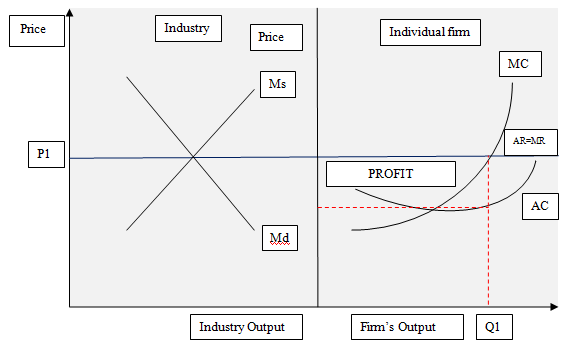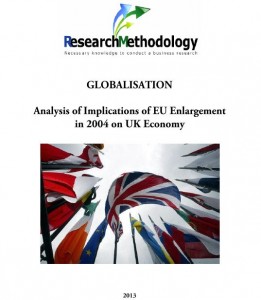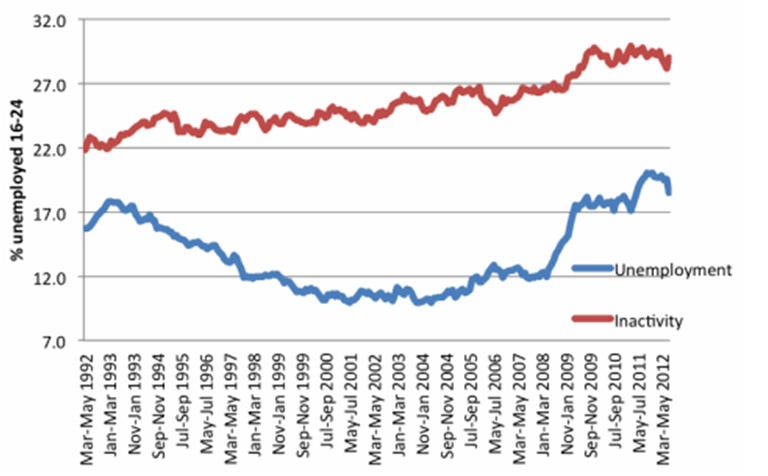Economics

Perfect competition can be defined as a situation “in an industry when that industry is made up of many small firms producing homogeneous products, when there is no impediment to the entry or exit of firms, and when full information is available” (Baumon and Blinder, 2011, p.200). Market structure can be specified as perfect competition if the following conditions or assumptions are met: Firstly, there are many supplies in the market and each supplier has an insignificant market share. In other words, no single supplier is in the position of impacting price through manipulations with its supply of products. Secondly, there are no major differences between products offered by suppliers and these products can be consumed as substitution for each-other. To be more specific, even when there are certain differences between products in the same industry, they are identical in consumer perception. Thirdly, consumers are fully aware about costs charged by all suppliers. This situation has implications in a way that a certain supplier decides to increase its prices; the levels of its revenues will decline because of consumers switching to other suppliers. Fourthly, the level of access to various resources is equal for all suppliers. Moreover, all participants in the industry can benefit from breakthroughs and other positive changes in the industry in an equal manner. Fifthly, industry entry and exit barriers for suppliers are insignificant. In other words, new suppliers can join competition at any time with implications on the levels of profits of existing suppliers. Sixthly, there is no divergence between private costs and social costs, as well as, benefits due to the absence of externality in manufacturing and consumption. Six main assumptions associated with perfect competition market structure discussed above have certain implications on profit maximisation attempts of businesses. Outcome of interaction between supply and demand…

Burke (2012) links the impacts of the global economic crisis of 2008-2010 with spending cuts on education system by the UK government. Chalabi and Arnett (2013), on the other hand, make an interesting observation related to the issue. Specifically, according to Chalabi and Arnett (2013), the levels of GDP in the UK decreased by 2 per cent between 2008 and 2010, whereas the levels of public expenditure on education have increased by 8 per cent during the same period. A large-scale survey conducted by Education Institution (2009) has attempted to assess impacts of the global economic crisis on education in 48 countries, including the UK. Infrastructure, human resources (HR), and other needs of the UK education system have been found as a result of the survey. Infrastructure needs of UK education system, according to Education Institution (2009) relates to necessity to rebuilt primary schools. Other needs are found to relate to funding for high quality continuing professional development of teachers and challenges associated with reforming curriculum and qualification system. However, it is important to note that Education Institution (2009) findings only relate to education in public sector, and the level of relevance of data to private sector educational institutions are yet to be established. Burke (2012) considers dramatic reduction of numbers of graduate employment schemes offered by multinational companies in 2009 as the direct impact of the global economic crisis. Although, this argument appears to be convincing, Burke (2012) fails to back-up the claim through referring to relevant statistical data. Vaitilingam (2010) points to the risk of lifetime earning loss for a generation of graduates that join full-time workforce during or immediate aftermath of recession. According to Vaitilingam (2010), this situation may occur due to rapid increase in the supply of graduates compared to jobs caused by cuts on graduate…

National economy of the UK entered the period of recession on the fourth quarter of 2008. Review of literature has found consensus amongst authors about significant negative impacts of the global economic crisis of 2008-2010 on UK economy. The lowest level of recession in UK occurred in June 2009, when the decline of economy has amounted to 5.5 per cent compared to its peak in Quarter 1, 2008 (Vaitilingam, 2010). According to Bell and Blanchflower (2011), the crisis has resulted in substantial cuts on government spending, reduction on the levels of household spending, and has contributed to the emergence of uncertain and volatile investment climate. Impacts of the crisis on jobs in the UK have been analysed by Vaitilingam (2010) in a detailed manner. To be more specific, Vaitilingam (2010) assesses job-related impacts of the global economic crisis of 2008-2010 to include increase on the levels of unemployment and regional disparities in Britain’s economic geography. Additionally, Vaitilingam (2010) specifies low-educated and low-skilled employees, as well as, older workers to be most disadvantaged in terms of being negatively impacted from the crisis. Sobel (2012) draws attention to personal and emotional implications of the crisis to daily lives of people in the UK and elsewhere. According to Sobel (2012) due attention is not paid to this specific aspect of the crisis and the authors stresses the necessity for additional researches in this area. References Bell, D.N. & Blanchflower, D.G. (2011) “The crisis, policy reactions and attitudes to globalisation and jobs” WTO Sobel, A.C. (2012) “Birth of Hegemony: Crisis, Financial Revolution, and Emerging Global Networks” University of Chicago Press Vaitilingam, R. (2010) “Recession Britain: Findings from economic and social research” Economic & Research Council
There is a large volume of published studies analysing major reasons of the global economic crisis of 2008-2010. Excessive risk taking by financial institutions in the US combined with inefficiencies with US housing regulations is shown as primary causes of global recession by Roberts (2009) and Heng (2010). Heng (2010) offers detailed account of the issue and effectively demonstrates that US-based financial institutions have encouraged individuals with no adequate credit history to own homes and rapid decline of house prices, phenomenon known as ‘housing bubble’ has given start to a severe global financial and economic crisis. A study conducted by Sobel (2012) confirms excessive risk taking and inefficiencies with housing regulations as reasons behind the economic crisis and also discussed additional factors not mentioned by many other authors. Specifically, according to Sobel (2012), inadequacies in formulating interest rate policies, as well as, policies to suppress inflation in the US have also played major role in creation of environment that led to the global economic crisis of 2008-2010. Globalisation is perceived by Tan (2010) as one of the major enabling factors of the global economic crisis of 2008-2010. The topic of globalisation is addressed by Samson and Daft (2012) in great details. Specifically, Samson and Daft (2012) divide globalisation into four stages and cultural sensitivity and managerial assumptions in each stage in the following manner: 1. Domestic 2. International 3. Multinational 4. Global Strategic orientation Domestically oriented Export-oriented, multi-domestic Multinational Global Stage of development Initial foreign involvement Competitive positioning Exposition of international operations Global Cultural sensitivity Of little importance Very important Somew hat important Critically important Manager assumptions ‘one best way’ ‘many good ways’ ‘the least-cost way’ ‘many good ways’ Four stages of globalisation Source: Samson and Daft (2012) However, while linking financial crisis and globalisation, Tan (2010) fails to…

Explanation of the outbreak of the Great Recession of 2007-8 in a chronological order is necessary in order to provide detailed information about the case study, and link discussions and analysis in following chapters to specific events within the chronology. Date Event 2007 AugustOctober December Funds freezed by the US Federal ReserveRecord high at Dow Jones Official start of the recession in the US 2008 MarchJuly September October November Collapse of Bear SternsGDP fall of 0.6% confirmed Denmark as the first European economy to face recession Record unemployment rate in the US during the last 5 years Takeover of Fannie Mae and Freddie Mac US President George Bush signs USD 700 billion bailout fund Singapore is the first Asian country to face recession with the economy shrinking 6.3% Hong Kong confirmed as the 2nd Asian country to face recession 2009 JanuaryFebruary June GDP fall of 1.5% in 4thquarter of 2008, confirms the beginning of recession in the UKObama stimulus package signed Issue of Greece’s budget deficit emerge 2010 JanuaryApril October UK economy comes out of recession with a GDP growth of 0.1%Creation of 162,000 job in the UK Greece and Ireland are bailed out in the EU as a result of adoption of austerity measures 2011 April May Portugal asking for the EU help in dealing with its financesPlanning of a permanent rescue fund in EU by leaders of its members The loss of US AAA credit rating Approval of EURO 78 billion bailout for Portugal by EU leaders Chronology of the Great Recession of 2007-8 Source: Roberts (2009), Heng (2010) and Hetzel (2012) References Heng, M.S. (2010) The Great Recession: History, Ideology, Hubris and Nemesis, World Scientific Hetzel, R.L. (2012) The Great Recession: Market Failure or Policy Failure, Cambridge University Press Roberts ,M. (2009) The…

Rentier state theory is “a political economy theory that seeks to explain state-society relations in states that generate a large proportion of their income from rents, or externally-derived, unproductively-earned payments” (Gray, 2011, p.1). In simple terms, rentier states derive substantial proportions of their revenues from renting their sources of natural resources to external parties. Rentier states are less motivated to offer concessions to individuals because it is less dependant of taxation to execute its duties, receiving substantial amounts of funds from abroad. Development of rentierism and rentier state theory into academic and practical levels can be divided into the following three phases: classical rentier state theory, the second phase of rientierism and late rientierism. Classical Rentier Theory The first phase of rentierism encompasses the period from the beginning of 1980’s and to the early 1990’s. This period is marked with immediate aftermath of Iranian revolution and Iran-Iraq war of 1980-1988. According to Elbadawi and Maksidi (2010), these both events have played significant role on fluctuations of world oil prices, with implications on global scale. Jenkins et al. (2011) argue that this period of time is associated with a harsh, dictatorial rule of heads of rentier states. Moreover, Jenkins et al. (2011) note about misallocation of wealth, high levels of corruption and overall inefficiencies in rentier Gulf states during the phase. The Second Phase of Rentierism The validity of governments of rentier states being challenged, both, internally and externally is one of the main tendencies marking the second phase of rentierism. Specific factor contributing to these tendencies has been named as phenomenal economic developments in Dubai that served as a point for comparison by people from other oil rich countries in the region. Moreover, during the second phase of rentierism economic scholars acknowledged that the relationship between the levels…

This report represents a brief assessment of various aspects of primary education in the UK as an important merit good. The report starts with assessing the role of the UK government in providing primary education and this is followed by analysis of possibilities for private sector to provide primary education. Moreover, the report includes discussions of positive externalities of primary education and assesses the possibilities of market failure if the provision of primary education was left to provide to free market. Socially desirable merit goods are “goods that society deems so valuable that everyone should have them” (Frischmann, 2012, p.45). There are two basic characteristics of merit goods: the value of the good is not usually fully appreciated at the time of consumption, and consumption of merit goods has positive effects to other individuals (Economics Online, 2013). 1. Introduction 3 2. The Role of Government in Providing Primary Education 3 3. Private Sector as Provider of Primary Education 4 4. Positive Externalities of Primary Education 5 5. Provision of Primary Education by free Market and Possibility of Market Failure 7 6. Conclusions and Recommendations 9 References 10 How do I receive the report? Once payment is made you will receive a link to you e-mail you have registered with on Pay Pal or the e-email you have entered when specifying bank details to download the report. The report is downloaded in PDF format. The link will stay active for 7 days. How can I use the report to complete my academic assignment/research? Reports and essays offered by research-methodology.net are professionally written samples in their respective areas. Reports and essays are intended to be used as guides and sources of secondary data for reference purposes. I did not receive the link/I can not download the report? If you have any difficulties…

On May 1, 2004 the European Union (UN) has been enlarged to comprise additional ten countries with combined population of almost 75 million people. Specifically, new countries that formally entered EU consist of Estonia, Latvia, Lithuania, Poland, Czech Republic, Hungary, Slovakia, Slovenia, Cyprus and Malta. This important geo-political event has had significant implications on national economic, social and political life of all original member countries of the EU (Europa, 2013, online).This essay analyses the impacts of EU enlargement on the state of national economy in the UK focusing on labour migration. The essay starts with discussions about the reasons for the enlargement of EU in 2004. This is followed by analysis of implications of enlargement of EU to the state of national economy in the UK as compared to expectations. Moreover, the essay is going comprises the overview of measures initiated by the UK government in order to address the potential negative implications of the EU enlargement on the state of the national economy in the UK. The essay is concluded by discussing various scenarios in the development of immigration policies in the UK with the aims of protecting national economy from negative impact of a range of internal and external factors. After the fifth EU enlargement in 2004, the majority of Western European countries (EU15) have introduced temporary restrictions on the movement of individuals from newly EU member states in order to protect their national economies from the large uncontrolled inflow of low-skilled immigrants. Such restrictions were not applied only by the UK, Ireland, and Sweden (Longhi and Rokicka, 2012), and the implications of this government decision for the UK are assessed further below. Introduction 1 Reasons for the enlargement of EU in 2004 2 Implications of enlargement of EU to the state of national economy in the UK…

Unemployment is serious social and economic issue for the society, and unemployed individuals in many levels. Unemployment amongst young people is considered to be a special case as “young people between their required school life and their first job are very susceptible to unemployment” (Kurten, 2007, p.3). Moreover, a high level of youth unemployment has massive negative implications for the government on short-term and long-term perspectives. According to International Labour Office (2012), individuals aged between 16 – 25, who are available for work in 15 days, not currently employed, and are looking for employment opportunities in an active manner can be classified as young unemployed. However, in the UK, the age range of young unemployed individuals is specified as 16 – 24 years old. The level of youth unemployment has been consistently rising in the UK during the past several years (Figure 1). Moreover, it has been estimated that the numbers of young individuals who have not been working for more than 2 years have increased from 40,000 to more than 100,000 during the last four years, amounting to the increase of 168 per cent, and the numbers of Job Seeker Allowance claimants amongst young people have increased 315 per cent during the last six month (Al-Katib, 2012). Figure 1 Youth unemployment and inactivity statistics Source: Office of National Statistics (2012) The lack of skills and experience amongst young people in the UK is considered to belong to the list of major reasons behind increasing level of unemployment. Moreover, continuing economic problems in the EU and the UK have been found to have negative implications on the local job market in UK in general, and the job market for young people in particular. There is a stark difference on the levels of employment amongst young people who are engaged in…

This paper represents a case study report devoted on the issue of increasing levels of youth unemployment in the UK. The report starts with a brief description of relevant existing key policies. This is followed by the identification of gaps on youth unemployment that need to be addressed. The report also contains discussions about relevant policy goals and the extent of their alignment with government preferences. Moreover, relevant policy options analyses are included in this report with detailed explanations of two the most suitable and appropriate policy options taking into account present economic and political circumstances in the UK. The report is concluded by making recommendations regarding the implementation of a specific policy option with detailed explanations provided. Youth unemployment is proving to be a serious challenge in the UK with highly negative short-term and long-term economic and social implications. Specifically, nearly 1.5 million, or more than 20 per cent of young people in the UK are found to be not engaged in education, employment or training (ACEVO, 2012). Moreover, according to estimations, the net present value cost of youth unemployment for the next ten years is going to amount to £28 billion (ACEVO, 2012). A wide range of negative implications of youth unemployment include negative impact on national economy for short-term and long-term perspectives, negative impact on future earning potentials of youth involved, detrimental impacts on mental and individual health of young individuals involved (Gregg et al., 2011), and increase in the level of anti-social behaviour within the society (Howell, 2005). The major reasons for increasing levels of youth unemployment in the UK have been specified as the recent global economic and financial crisis, failure in the UK immigration policies (Sunley et al., 2011), and systematic employment policy failures (Furlong, 2012). 1. Introduction: Nature of the Problem 1 2.…
